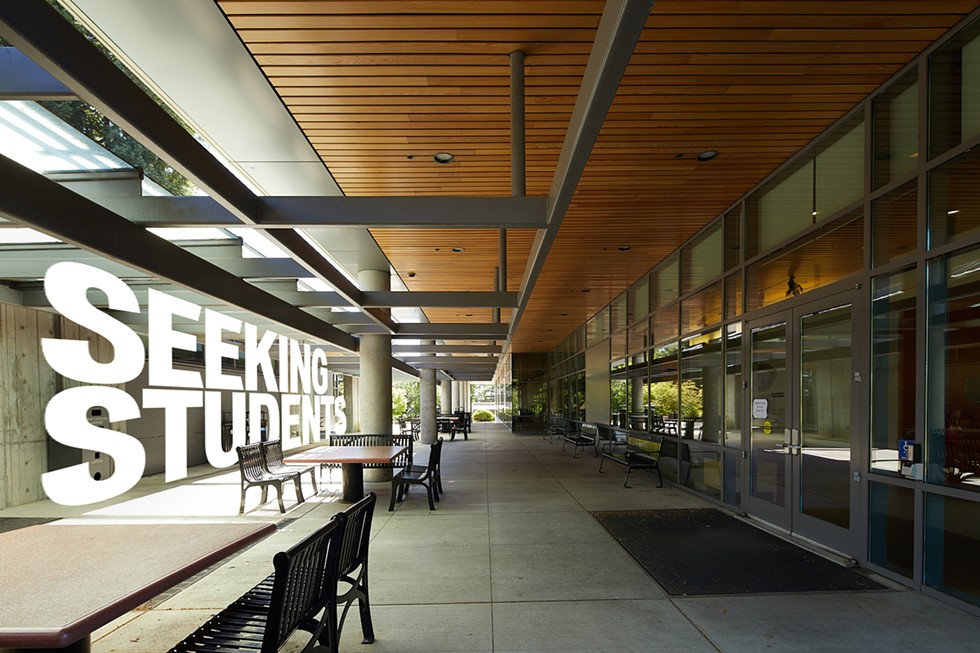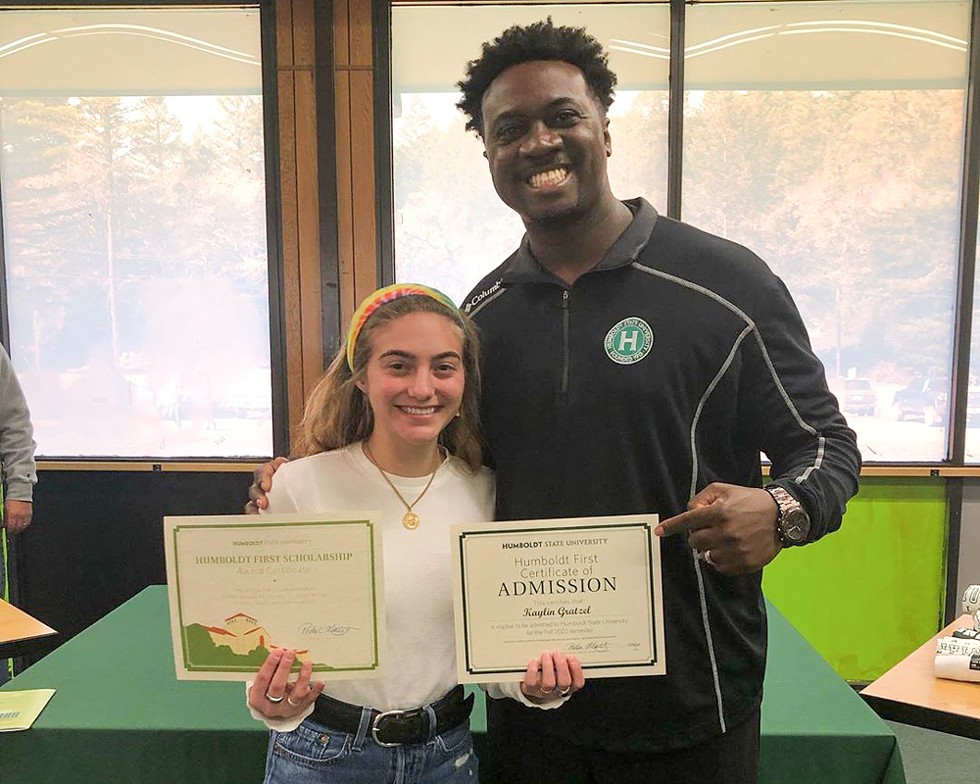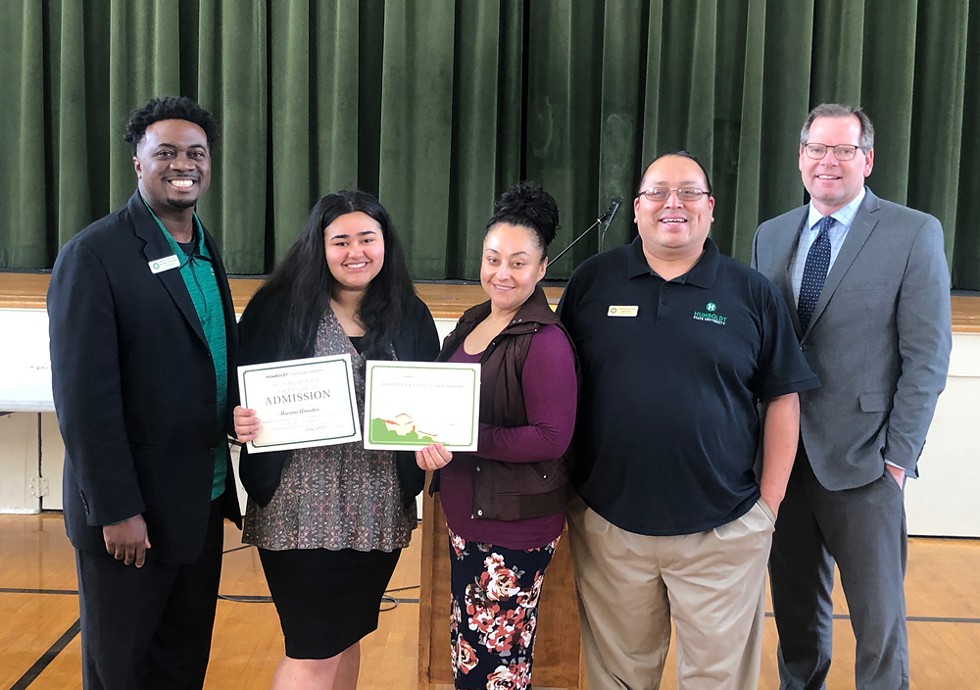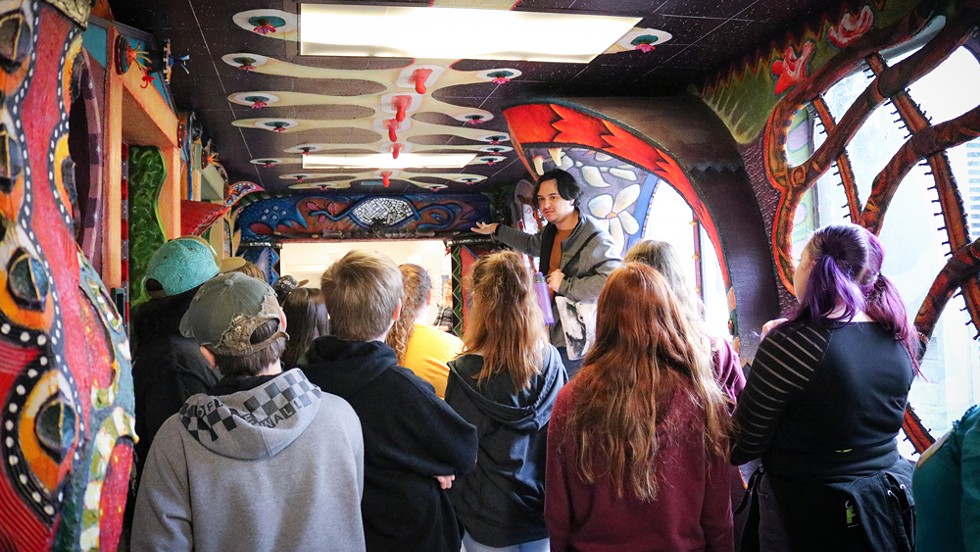Seeking Students
Facing declining enrollment and a resulting budget deficit, HSU doubles down on recruitment
By Iridian Casarez [email protected][
{
"name": "Top Stories Video Pair",
"insertPoint": "15",
"component": "17087298",
"parentWrapperClass": "fdn-ads-inline-content-block",
"requiredCountToDisplay": "1"
}
]
Being offered a Humboldt First Scholarship is an experience in and of itself. Humboldt State University Vice President of Enrollment Management Jason Meriwether, President Tom Jackson Jr. and Lucky the Logger, HSU's mascot, visit local high schools and offer seniors a $4,000 scholarship in an event carefully tailored to feel like a graduation ceremony.
After an inspirational speech by Jackson, one by one, students are called up by name to receive their certificate of admissions and scholarship, and, similar to a commencement ceremony, shake hands with HSU officials, all while Lucky the Logger cheers them on.
"Welcome to the Lumberjack family," Jackson tells the auditorium filled with close to 100 Eureka High School seniors. "Take the money and run. Go Lumberjacks."
It's HSU's way of saying it's investing in local students, something it hasn't always done in the past, says Meriwether.
"If you look at high school populations locally, Humboldt has really struggled in the last few years on recruitment of local students," he says. "I believe that's why you see all this interest in Humboldt First. ... It all demonstrates, 'Hey, Humboldt is serious about local students,' and that hadn't been the case in a few years."
To date, 700 local high school seniors have been offered the Humboldt First Scholarship, which is divided into four installments of $1,000 for each year a student is enrolled and in good academic standing.
But this is just a snippet of HSU's recent efforts to boost enrollment and admissions applications. It's a small part of a bigger picture — and a bigger investment — to stave off a looming budget crisis.
HSU has seen a sharp decline in enrollment, with the current student population at 6,763 — that's about 1,000 students fewer than last year. The decline — 13-percent from last year and 18 percent from the university's peak enrollment four years ago — is severely impacting HSU's budget as each student on campus represents a revenue stream. The University Resource and Planning Committee (URPC) is proposing the university cut the budget by $5.4 million over the next two years due to a structural deficit created by the enrollment declines.
Amber Blakeslee, director of HSU's budget office, says enrollment, retention and graduation rates all have an effect on the budget. Student tuition — currently at $5,742 a year for in-state students — is the university's second biggest revenue source that covers operating costs and basic instruction.
"Tuition, combined with state support, is what we're looking at for operating funds," she says. "The bottom line is less enrollment means less money goes into the budget."
The state contributes a large portion of the school's annual revenue. This year, its contributions made up 65 percent of the university's budget, or $90.7 million. California State University spokesperson Toni Molle wrote in an email to the Journal that the chancellor's office allocates funding to campuses based on enrollment and to cover mandatory cost increases, but has not reduced funds because of lost enrollment. Relatively stable state funding, he adds, can help soften the blow of lost tuition revenue from enrollment dips.
According to HSU's 2019-2020 budget, tuition is projected to bring in $34.6 million, or 26 percent of the school's total revenue. When the school had its highest ever enrollment in the 2015-2016 year, tuition brought in $45.1 million, accounting for 36 percent of the university's budget.
Consequently, student enrollment is inherently part of budget planning, as the university tries to keep its student population — and revenue streams — stable even as it loses large groups of students through graduation. The current trend sees a larger number of students graduating than new students enrolling.
Stephanie Burkhalter, a politics professor who chairs HSU's University Senate, says in an email to the Journal that the university's new enrollment management team has done a terrific job of recruiting local students, but added things would be better if HSU "had begun some of these aggressive and concentrated strategies years ago."
Burkhalter adds that before Meriwether's arrival, Randy Hyman spent a year as the interim vice president of enrollment. For years prior to that, HSU did not have an enrollment specialist, she says.
HSU graduation rates have increased 51 percent since 2018, which is what the university aims to achieve, but with lower student enrollment to offset the graduation rates, it creates compression. The large graduating classes without the same amount of students enrolling — or staying — creates an imbalance of tuition revenue.
But in the first year of Jackson's tenure, HSU is working hard to reverse that trend. The new administration is revamping how the school recruits students, using new technology, programs, investments and data to its advantage.
Meriwether says his department and the Office of Admissions, working together, have found new ways to recruit students strategically.
HSU administrators divided California into five regions and looked at all of the high schools and community colleges in each. Then they began data mining. They looked at which schools had produced the most HSU applicants, how many students from each school were accepted, admitted and actually enrolled. Once they found the schools with the top number of graduates enrolled at HSU, they looked for patterns.
"If you watch [the patterns] over the course of the past four or five years, you see the ebb, you see the flow, who's coming from where, and you say, 'OK, these are our top feeders,'" Meriwether says. "... And from there it's a data mining process to say, 'Gosh, we were performing so well at this school in 2016, what happened?' or, 'We've been noticing some moderate improvement in this school, how do we grow on that?' or, 'This seems to be fertile ground, we haven't done well here, but why not?'"
The admissions office uses this data analysis to determine where to focus recruitment efforts. As an example, the admissions office might see a school where a couple of hundred students apply and, of those, 100 are admitted but only 20 actually enroll and really analyze what it could do differently in its recruitment efforts to get a higher percentage of students to choose HSU.
This is where the school administrators are taking advantage of data. They see where the yield rate (students who actually enrolled against the total number who applied) is lacking and make adjustments to their efforts. But in addition to increasing its yield rate, HSU is also pushing to get more appplicants.
Meriwether says the school is seeing a decline in applications, receiving about 15,000 a year, whereas at its peak the school was getting 18,000. (Meriwether says the school's goal should be 20,000 applications a year.)
But HSU isn't alone in experiencing this enrollment decline. According to the National Student Clearinghouse Research Center, in fall of 2019 postsecondary enrollments decreased 1.3 percent nationwide, a drop of more than 231,000 students from the previous fall. California saw an enrollment decline of 19,272 students.
According to the Fall 2019 Current Enrollment Estimates, "For the first time in the decade, the nation's fall unduplicated enrollments fell below 18 million students and declined by more than 2 million students."
Looking to combat that trend, HSU is making it personal and getting determined. It's important, Meriwether says, that potential students hear from HSU every 25 to 30 days, adding that it's crucial to build relationships and let them know HSU is serious about recruiting them. It's a similar mentality to HSU's approach to fundraising and courting donors.
"[Potential] students have to experience us in a plethora of avenues," Meriwether says. "With that in mind, students have to get collateral mail ... they need to hear from us via text messages, through social media, digital ads. ... We've amped our communications."
And those communications are now more targeted than ever before. HSU purchased the names of students who have taken the Scholastic Aptitude Test (SAT) and the American College Testing (ACT) in order to send them "collateral mail" and do other direct marketing and outreach.
Historically, HSU has not taken advantage of name purchasing to the degree the new admissions team has. Meriwether says it made a huge investment buying the names of every high school junior and senior (who took the tests) in California and some other western states.
"That's the game," he says. "We're playing that game now and we're playing it very aggressively."
From a resource standpoint, the university now has a long list of potential students to recruit and that's where its "aggressive" efforts start.
This year, HSU purchased a new software called Mongoose, a text messaging platform that helps the admissions office contact potential first-time freshman and transfer students. Prospective students can also respond and ask questions about campus life, financial aid packages, majors, programs and events.
On top of that, HSU has invested in purchasing pop-up ads on Spotify and contracted with a company that digitally targets high school and transfer students through social media applications like Snapchat, Instagram and Facebook. The company uses the list of names the school purchased from the ACT and SAT and geo-targets content to users based on their geographic location to send them information about the school. The company also has data science technology that takes the list of students who took college entrance exams and filters those more likely to enroll at HSU so they can be targeted more directly.
But HSU is not just spamming its way into the lives of future students. It's also making its recruiting efforts more personal. Meriwhether says that once a student has applied and identified an intended major, the admissions office encourages department chairs to contact them directly.
For example, Maxwell Schnurer, the department chair for the communications major, says his department is in direct contact with potential students and their families through emails, phone calls and personalized letters.
International Studies Department Chair Alison Holmes says the admissions office has developed a coordinated movement, bringing department chairs into the effort to boost enrollment.
"[Recruitment] efforts have been really patchy in the past," she says. "But it's now a joint effort."
Schnurer, Holmes and other department chairs are also participating in a phone bank with the admissions office in the near future. Just like the text messaging software, HSU will be contacting students to field any questions they have about the university or majors and departments, says Peter Martinez, HSU's director of admissions. Not only is the phone bank an opportunity for outreach, it's also an opportunity for the university to gather more information.
"We're collecting data about the types of questions students are asking," Martinez says. "We're keeping track of it so that in the long run we can see what students are interested in. We can say, 'OK, 50 percent of students asked about the financial aid packet. Where can we make that information more clear?'"
According to Martinez, the school is also collecting data through the text-messaging software that customizes text responses for students asking a particular question.
For example, if a student wants to know more about the International Studies Department, they are directed straight to Holmes or an HSU student majoring in the program.
As a secondary component to boosting enrollment numbers, HSU is also looking to increase retention rates, which can to some extent help offset the lost revenue from having fewer incoming freshmen and transfer students. An important indicator of stable student enrollment is the retention rates for freshman.
Meriwether says it's the first hurdle and sets the stage for more students to persist. Right now, HSU is seeing an improvement in freshman retention rates. In the last three years, HSU's freshman retention rates have increased from 69 percent to 75 percent. However, Meriwether says the school should have an 80 percent retention rate, which is roughly the national average, according to the National Center for Education Statistics.
Lisa Castellino, HSU's associate vice president of institutional effectiveness, wrote in an article on the Humboldt State Now website that retention is influenced by a number of factors, including students feeling connected to the campus and their major, their academic progress and whether they "see a roadmap to a career."
In an effort to make students feel more connected to the campus, HSU is also investing more of its stretched budget into student life.
When Meriwether started at HSU in July, he told his department staff that every time they spend money they need to answer two basic questions: How does the spending help students and how does it align with HSU's strategic plan?
"Without clear answers to those questions, we can't make good decisions," he says.
But the office also realizes investment is needed and has tried to spend strategically.
As a way to increase retention, HSU launched HumBot, a text messaging software designed to answer questions from current students about the university, "to help navigate student life" and help students feel more connected to the campus.
The Humboldt State University Foundation has also allocated a total of $150,000 from its budget over the next three years for the university's cultural centers for academic excellence, a student resource that has seen very little funding in the past but is designed to "promote individual and academic advancement in a culturally welcoming and dynamic environment."
The school also invested in bringing Black History Month speakers and events to campus through the African American Center for Academic Excellence last month.
Another part of the school's retention efforts is putting some fun into the student-life experience. The university began throwing "Thursday Night in the Depot" concerts, Meriwether says, to bring life to a "dead" campus. The school is also bringing rapper 21 Savage to campus to perform in April and announced he will have an HSU student as one of his opening acts. The concert is the result of a student survey in which HSU asked students who they would like to see perform at the university. Meriwether says it was important to offer an event students wanted to see, to invest student fees into what students actually want.
"[These events] are things that will help students feel connected to the campus," Meriwether says. "These are events that should be a part of the student-experience. It's part of having a real college experience."
These are all small parts of a bigger picture, investments HSU hopes will pay off and result in stable enrollment in the future. In the meantime, HSU is committed to building a relationship with local high school and even middle school students.
HSU's "I've Been Admitted to College" (IBAC) program brings eighth graders from local schools to visit the campus, take a tour and catch a glimpse of all of the resources and technology HSU students have available to them. Meriwether says he wants these students to recognize the academic quality HSU has to offer.
For example, eighth graders get to visit HSU's new kinesiology building and observe the type of equipment its students use in their classes and research.
For IBAC program Coordinator Molly Pucillo, it's important for middle school students to "dip their toes" into what it means to go to college. She says the program not only gives them an insight of what to prepare for, but also gives them an opportunity to experience student life at HSU.
"We're really focused on trying to get eighth graders to really dive into what they could be beyond the four walls of a ... classroom," Martinez says. "[HSU] want(s) them to discover all the different resources. ... We feel like we have a space for them and we know we are going to offer them a space. We give them a certificate to remind them, 'HSU has a reserved spot for you, we have that space for you.'"
Meriwether believes that it's not enough to just visit high schools and middle schools to recruit or offer scholarships. He says it's important to build relationships with the students, adding that Humboldt First Scholarship recipients should keep hearing from HSU after they have been offered the scholarship. That's why the university invited high school and College of the Redwoods students to a home basketball game on Feb. 27 and is planning on throwing more high school nights with each local high school in the coming months. It is also reserving 200 tickets to the 21 Savage Concert for Humboldt First Scholarship recipients.
Meriwether says he wants local students to know that these are the types of adventures and encounters they will experience at HSU, the type of events HSU holds for its students.
Jackson is expected to release his budget proposal in the near future and it is certain to contain some deep cuts to a campus budget that has experienced many in recent years. But that's the difficult reality of seeing enrollment drop 13 percent in a single year, and why the university has invested in a data-driven, multi-pronged approach to bring more students to campus.
"The strategic thing about the data I talked about is that it really puts us in a position to really be intelligent about [our recruitment efforts]," Meriwether says. "This is a process; it's a marathon; it's a three- to four-year journey to finish this turn around but we're committed to it."
Iridian Casarez is a staff writer at the Journal and prefers she/her pronouns. Reach her at 442-1400, extension 317, or [email protected]. Follow her on Twitter @IridianCasarez.
Speaking of...
-

Robert William Astrue: 1928-2023
Feb 13, 2024 -

Susan Ellisa MacConnie: 1952-2023
Oct 1, 2023 -

Cal Poly Humboldt Admin Optimistic Despite Not Meeting Enrollment Projections
Sep 12, 2023 - More »
more from the author
-
An Upstream Intervention
Open Door hopes state grant will help address impacts of childhood trauma
- Feb 9, 2023
-
Humboldt County Still Working to Implement Organic Waste System
- Feb 2, 2023
-
Earl Robert Bootier: 1945-2022
- Jan 25, 2023
- More »
Latest in News
Readers also liked…
-
Through Mark Larson's Lens
A local photographer's favorite images of 2022 in Humboldt
- Jan 5, 2023
-
'To Celebrate Our Sovereignty'
Yurok Tribe to host gathering honoring 'ultimate river warrior' on the anniversary of the U.S. Supreme Court ruling that changed everything
- Jun 8, 2023
































